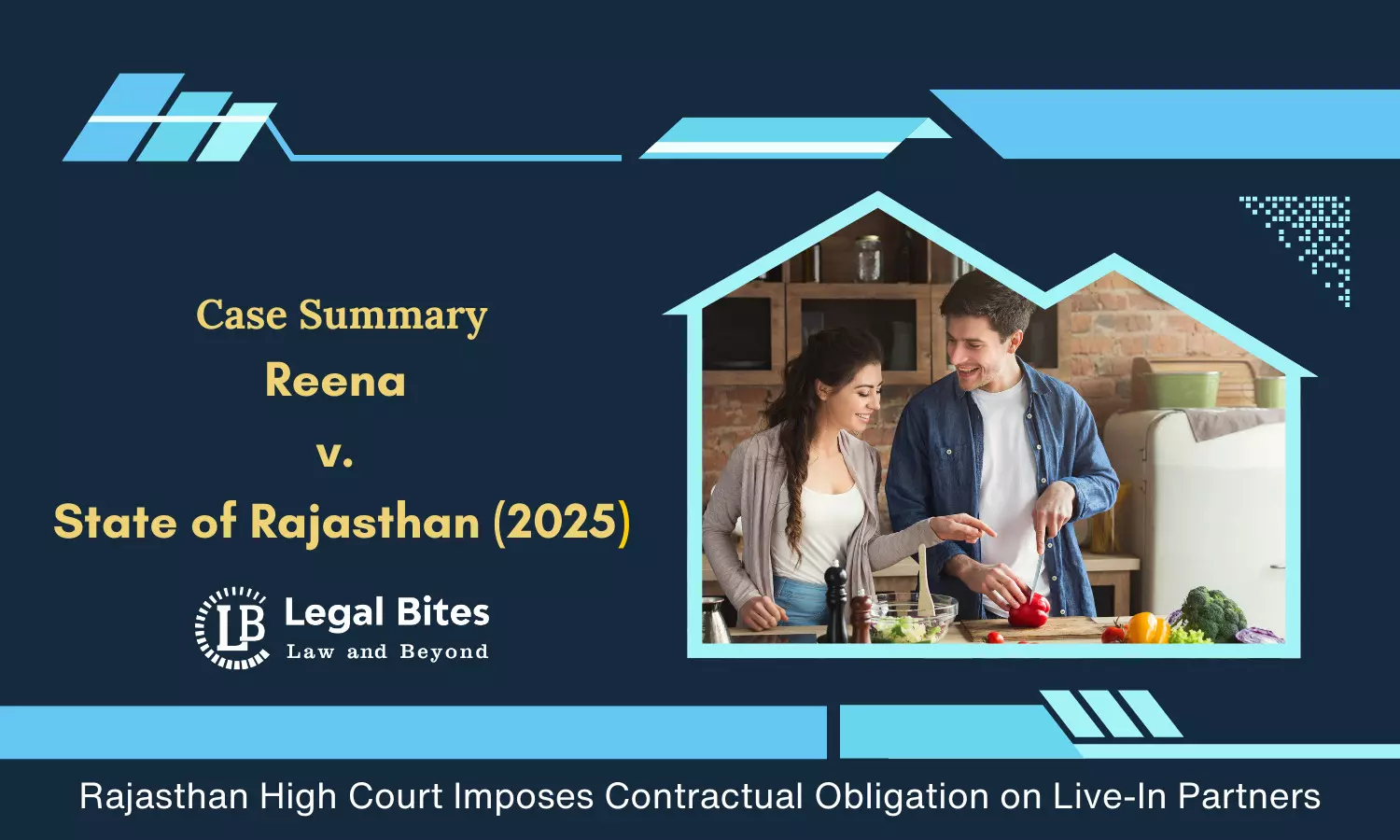Case Summary: Reena v. State of Rajasthan (2025) | Rajasthan High Court Imposes Contractual Obligation on Live-In Partners
Rajasthan High Court examines legal protection for live-in couples, balancing constitutional rights, personal liberty, and societal norms

The case highlights the conflict between personal liberty and societal norms, requiring judicial intervention to clarify the legal standing of such relationships. The Court has emphasized the urgent need for legislative clarity, while also considering interim measures, such as mandatory registration of live-in relationships, to ensure accountability and protection for individuals, particularly women and children born out of such relationships.
Case Title: Reena v. State of Rajasthan
Court: High Court of Judicature for Rajasthan, Jaipur Bench
Citation: 2025:RJ-JP:1930
Judge: Justice Anoop Kumar Dhand
Judgment on: 29/01/2025
Facts of the Case
Several petitioners approached the Court, citing threats from their families and societal opposition due to their choice to live in live-in relationships. The petitioners, hailing from different states, sought protection against intimidation and harm. The respondents in these cases included the State of Rajasthan, police authorities, and family members alleged to be posing threats. The cases raise significant questions about the rights of individuals in non-traditional relationships and the extent of constitutional protection available to them.
Legal Issue
The primary legal issue before the Court was:
- Whether individuals in live-in relationships, particularly when one or both partners are married without legal dissolution of prior marriages, are entitled to protection under Article 21 of the Constitution.
Judicial Precedents & Observations
1) Recognition of Live-in Relationships
- The Court acknowledged that India is gradually adopting Western concepts, including live-in relationships, though they remain legally unrecognized under the Hindu Marriage Act, 1955, and are considered impermissible under Muslim law.
- The Supreme Court, in S. Khushboo v. Kanniammal & Anr. (2010) and Indra Sarma v. V.K.V. Sarma (2013), held that live-in relationships are not illegal and are protected under Article 21.
- In Lata Singh v. State of UP (2006), the Supreme Court upheld the right of consenting adults to cohabit without interference from society or the State.
2) Legal Status of Live-in Relationships
- In D. Velusamy v. D. Patchaiammal (2010), the Supreme Court outlined conditions for a live-in relationship to be akin to marriage, including:
a) Public acknowledgement as spouses,
b) Legal age to marry,
c) Neither partner being married,
d) Significant duration of cohabitation.
- Indra Sarma (2013) further distinguished live-in relationships from marriage, emphasizing that a married person engaging in a live-in relationship may not claim the same rights.
3) Conflicting High Court Decisions
In Favour of Protection:
- Leela Bishnoi v. State of Rajasthan (2021) granted protection to a live-in couple, citing Article 21 rights.
- Manisha Devi v. State of Rajasthan (2023) upheld privacy rights, stating societal morality cannot override constitutional morality.
- Manisha Rani v. State of Rajasthan (2021) reinforced that the police must protect life and liberty under Section 29 of the Rajasthan Police Act, 2007.
Against Protection:
- Rashika Khandal v. State of Rajasthan (2021) denied protection to a live-in relationship where one partner was already married.
- Suman Kumari v. State of Rajasthan (2023) held that married persons in live-in relationships could not seek protection.
- Punjab & Haryana High Court in XXXX v. State of Punjab (2024) ruled against granting protection to illicit relationships.
- Allahabad High Court in Smt. Aneeta v. State of U.P. (2021) held that law-abiding citizens who are already married cannot seek protection for live-in relationships.
4) Legal Vacuum and Need for Legislative Clarity
- The Court highlighted the lack of legislation governing live-in relationships, causing judicial inconsistency.
- It noted that Uttarakhand had enacted the Uniform Civil Code, 2024, which includes provisions regulating live-in relationships.
- The Court suggested that the Central and State Governments enact a law addressing rights, obligations, and protection mechanisms for individuals in live-in relationships.
Court's Observations & Directives
1. Need for a Standardized Approach
Recognizing conflicting High Court judgments, the Court emphasized the necessity for a uniform legal framework to guide courts and law enforcement in handling such cases.
2. Proposal for Registration of Live-in Relationships
Until legislation is enacted, the Court proposed a temporary registration system where couples entering live-in relationships must:
- Define financial responsibilities for children,
- Outline maintenance obligations for non-earning partners,
- Register their relationship with a competent authority.
The Court directed the State to establish a nodal officer in each district to handle such registrations and address protection requests.
3. Referral to Special/Larger Bench
Given the conflicting judgments, the Court referred the following legal question to a Special/Larger Bench:
“Whether a married person living with an unmarried person, without dissolution of his/her marriage, or/and whether two married persons with different marriages living in a live-in relationship, without dissolution of their marriages, are entitled to a protection order from the Court?”
The matter was placed before the Chief Justice on the administrative side for the constitution of a Special/Larger Bench.
Click Here to Read the Official Judgment
Conclusion
This case reflects the judiciary's struggle to balance constitutional rights with societal norms and legal principles. While personal liberty under Article 21 guarantees individuals the right to choose their partners, courts are divided on granting protection when live-in relationships involve legally married individuals. The High Court’s decision to refer the matter to a Special/Larger Bench aims to provide a definitive ruling, ensuring consistency in handling similar cases in the future. Until then, the Court has urged the State to establish mechanisms for registering and addressing the legal and social implications of live-in relationships.

